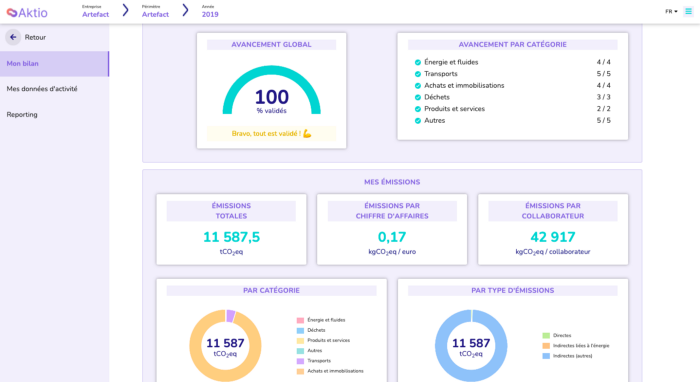8 lessons Artefact’s carbon footprint assessment taught us that could save your company time — and energy
CONTEXT
In March of this year, Artefact created GreenFact, our new pillar of Corporate Social Responsibility. GreenFact is responsible for federating energies and defining a roadmap to reduce the Group’s carbon emissions with the goal of becoming a carbon emission pacesetter by 2025. How?
CHALLENGE
The first step in achieving this transformation is to find your starting point — and that requires performing a carbon footprint assessment and defining an objective. We had to ask ourselves several questions: What data needs to be collected and how? How can adoption be promoted within the organisation? How can objectives be defined for a fast growing company?
KEY LESSONS
After several iterations, Artefact defined an approach that combines the SaaS carbon footprint solution proposed by Aktio with French regulatory repositories and the open-source platform, Cloud Carbon Footprint. (Cloud Carbon Footprint monitors the GHG emissions of cloud services such as GCP, AWS and Azure.)
We learned many valuable lessons along our journey: some were predictable, others were quite surprising. The purpose of this article is not only to share the approach we tested with other Artefact entities around the world, but also with all those who want to facilitate their carbon assessment initiatives.
(*Greenhouse gas emissions are categorised into three groups or ‘Scopes’ by the Greenhouse Gas (GHG) Protocol. Scope 1 covers direct emissions from owned or controlled sources. Scope 2 covers indirect emissions from the generation of purchased electricity, steam, heating and cooling consumed by the reporting company. Scope 3 includes all other indirect emissions that occur in a company’s value chain.)
1. Build a dedicated project team
Measuring your carbon footprint will take time and energy. Above all, it will take people — and persuasion. Even before you plunge into the task of building your project team, it’s vital to obtain the support of top management and to federate all your company’s divisions right from the start of the journey (Accountability, HR, IT, Office management…). You’ll be collecting data from all these entities, so you want them on board from day one.
Once management is on board, it’s time to build a corps of volunteers motivated by the project with as many diverse profiles as possible, all ready to put their business skills at the service of the cause. At Artefact, we sought highly invested volunteer employees from across the company to work in a guild divided into information-gathering teams (HR, finance, cloud computing, activation media…), knowing that the more and diverse talents we had, the faster we could collect the most — and most accurate — data. We were surprised by how many people wanted to immediately join the project; we gathered 30 people in a matter of days, and even now newcomers still want to join the project.
We assigned three project leads to coordinate the carbon assessment workflow. Through collaboration, competence sharing, and team cohesion, these information ambassadors can collect and calculate emissions data in your organisation, wherever it lies. Mini-missions can be devised to boost progress when obstacles arise. The key is to dedicate time to each team to maintain enthusiasm and continuous inspiration. It’s also a very important first step for the ownership and implementation of the action plan afterwards, potentially by the same people.
2. Equip yourself with the right tools
Once you’ve won the hearts of your sponsors and built your polyvalent project team, you’re ready to begin your carbon footprint assessment. But for that, you need the right tools.
And spreadsheets aren’t the answer, because when there are too many entries, spreadsheets stop being useful and start being clumsy.
The best science has come up with so far is carbon footprinting software. These solutions offer multi-user, customisable dashboards that let you enter historical data and update it with new data to measure your emissions, track your progress over the years, and set nuanced reduction targets.
At Artefact, we used the Aktio startup SaaS solution, a dashboard with Ademe’s Base Carbone® emission factors integrated. We highly recommend it: it’s great for storing data and they provide excellent customer support, answering all our questions on every possible subject. The Aktio dashboard organises data and identifies different indirect emission items (sometimes we can forget things, which is why their customer support is so great: they suggest six well-defined category ideas and 23 sub-sections to help us remember everything).


3. Never underestimate the importance of data quality
Nothing is more important than clean data. It’s essential to organise and store your data well so you can access it later, otherwise it will be very difficult to interpret. Sometimes the sources overlap, sometimes the data is in different places… but the risk is always the same: corrupted results.
Thanks to Aktio, we were able to avoid this problem, as they provided us with a data source tracking table. Fortunately, the first time an assessment is carried out is always the most difficult; it gets easier and up to 3x less time-consuming with each repetition.
The first carbon audit is an opportunity to put good practices for formatting and retrieving data in place for subsequent years. This will improve both the quality and value of future carbon footprints. With bad data quality, be prepared to waste time reorganising everything. It took us five months to collect and aggregate all the data at company level: one month for ready-to-use data (electricity, equipment, offices), two months for available data requiring a transformation process (travel, waste), two months for data not requiring a calculation process (cloud, media).
4. Start small but always think big
That’s an important lesson to be learned: errors and data corrections will likely occur, so plan for them.
Completing a carbon footprint audit requires a lot of iterations. It takes a long time, and is difficult to carry out in anything resembling a linear process. You simply have to accept that it is an imperfect and difficult exercise that will never be 100% completed.
So by adopting a “start small but always think big” mindset, you can begin with the easy parts and celebrate little victories as you achieve them with your community. For example, at Artefact, we focused on a simple framework to make our first approach.
We began with our electric bills in the context of Scope 1. It was a long process with lots of iterations, mistakes and rectifications. We hit a snag when we couldn’t find the electric bill for March, but eventually it turned up among the invoices for kitchen supplies for October.
We didn’t quite break out the champagne, but we did breathe a collective sigh of relief and took a five-minute break. That’s an important lesson to be learned: errors and data corrections will likely occur, so plan for them. For example, the data provided by our travel agency only covered 25% of our travel expenses! We only realised this a few weeks later… By anticipating errors, you won’t be taken by surprise when something bigger than an electric bill can’t be located.
5. Seek orders of magnitude, not exact figures
Measuring your financial data might be the easiest part of your carbon assessment, but results in high uncertainty as the emission factors used are broad average values. After all, when you have the figures right in front of you, it’s fairly easy to add them up. But the carbon footprint of a company is the total amount of greenhouse gases (GHG) emitted directly or indirectly through its activities, and some of those contributing factors can’t be measured with financial data and will require a more precise approach.
One good example is emissions produced by employee commuting. To measure these, you may need more than just your financial data: you may need to conduct a survey.
At Artefact, we began by calculating our emissions from employee commuting using accounting data linked to the number of employee transport passes in our records. But this data didn’t allow us to precisely estimate how employees travelled on a daily basis.
To solve this problem, we decided to carry out a survey to assess the modes of transport most frequently used by our employees. This data, although declarative, seemed to us to be more reliable in terms of estimation than the accounting data. We knew we couldn’t obtain exact figures but were simply seeking orders of magnitude to fulfil the requirement of our assessment.
6. Don’t compare your footprint to others
Comparing your carbon footprint to that of another company’s would be like comparing your genome to theirs: it isn’t fair as there will always be major differences in what different companies do. In order for two footprints to perfectly match, you’d need to find a company with the identical activity and organisation as yours — a clone, in effect — and implement the identical carbon footprint methodology (an impossibility unless carried out by the identical people!). Comparing yourself with your competitors is pointless, as none of them are of exactly the same size, nor do they have precisely the same products or scope of action.
There are other reasons that make benchmarking difficult. One of the largest hurdles for companies is the lack of a universal carbon benchmarking standard. Until a universal standard is established, companies will be unable to compare themselves across industries, sectors, and geographic regions and will continue to have to find workaround solutions.
Today, it is impossible to recover data from other actors, as the transparency process is just beginning, although in the coming years, European companies with more than 250 employees will be required to be transparent about their environmental, social and governance data. In Europe, this should affect more than 50,000 companies.
Finally, it’s important to remember that the aim of a carbon footprint is not to be “better” than others; it’s a self-assessment exercise designed to accelerate your own environmental transition. Very few companies are currently compatible with a +1.5°C planet, so even being better than a benchmark would be far from sufficient to ensure a relevant climate strategy.
The goal is to compare our performance with that of previous years and to dedicate ourselves to continuous improvement.
7. Keep an open mind: your results may surprise you
We had assumed the cloud would be the biggest culprit, but were shocked to discover that our media activity accounts for over 70% of our overall French emissions!
When tallying up your carbon costs during your footprint assessment, it’s best to be prepared for a few surprises, as the things you think will cost the most might very well cost the least — and vice versa!
The carbon cost of offices is relatively low but it doesn’t include the cost of your teleworkers’ homes and the energy they consume.
We always think that waste is the greatest of sins, yet for companies like Artefact that don’t manufacture or distribute physical goods, waste represents almost nothing in terms of carbon cost. We had assumed the cloud would be the biggest culprit, but were shocked to discover that our media activity accounts for over 70% of our overall French emissions!
If the software and digital services sector is perceived as a sector of immateriality, the multiplication of connected services and underlying physical infrastructure is not without environmental impact: the multiplication of datacentres, telecom networks and devices, and the increase in the volume of data exchanged on mobile networks and fibre optics are all vectors of growth in the impact of digital technology. The energy consumed by the resource-intensive computers and servers we use must also be carefully calculated: from their manufacture to their operation to their life cycles.
Yet 90% of our emissions (scopes 1,2,3) comes from the use of third parties and intermediaries, whose behaviour and climate commitments Artefact cannot really control. That’s why making our main service providers aware of the carbon assessment practice is crucial. Engaging our stakeholders on our quest to become more climate-friendly will help us all, in the very near future, because there are emissions reduction actions that require supply chain collaboration.
8. Create a workstream to attain reduction objectives
Setting a Greenhouse Gas (GHG) reduction goal can be complicated because there are so many different types of trajectories and objectives possible.We have considered two different approaches that are proposed by the Science-Based Targets Initiative (SBTi): absolute and intensity targets.
Initially, we wanted to aim for the absolute targets, but our intermediate company size and 30% annual growth make this goal impossible for the time being. Thanks to the intensity target approach, we applied a -7% reduction on CO2 emissions per euro of profit, and then calculated the tonnes of CO2 to have absolute targets for each subdivision of our business.
There are two main principles that need to be taken into account in applying this objective to our goal of becoming a carbon emission pacesetter by 2025.
No matter what science-based target your business chooses, it is important to keep in mind the overarching goal: stopping climate change. An objective is a compass to help define, prioritise and assess actions, but it should not limit them.
Conclusion
By performing the audit, we realised there were many dimensions to our company’s carbon footprint, some of which were quite surprising.
There were many direct benefits for Artefact that resulted from the audit. Aside from increasing our knowledge of environmental issues and discovering ways to be more eco-conscious, we also discovered a strong willingness among our employees to be part of the carbon-exemplarity initiative. We built a solid team of volunteers who were motivated to carry out the carbon assessment, which was very rewarding as it was hard work, but it allowed our people to develop their understanding of even the most subtle carbon impacts.
One of the most important lessons we learned, with regard to Scope 3, is the importance of maintaining good relationships with suppliers and partners in the hope of convincing them to engage in the same carbon reduction process.
Artefact’s approach is based on a voluntary initiative to become carbon-exemplary. Therefore, this carbon audit will not be a one-off but will be used as a management tool, with data collection and calculation updated and improved every year.
RESULT
After five months, we finished assessing our carbon footprint, and a month later we had defined our objectives thanks to a team of volunteers composed of more than 30 people. We limited our perimeter to our activities in France in 2019, as it preceded the upheaval brought about by Covid. As a result, our full scope carbon emissions represent 11,587.5 tCO2 eq. Considering that 98% of our GHG emissions fall within scope 3 and that some of these emissions remain difficult to quantify precisely at the moment, we decided to define an Artefact scope (representing 1,126 tCO2 eq) including all activities and emissions on which we can have a direct impact and for which we can quantify short-term reductions. For this scope, we applied an intensity objective of -7% per year to adhere as closely as possible to the standards defined by the Science Based Targets:
The next step is to define and implement solutions to reduce our emissions for the year 2022 by 141 tCO2 eq (compared to a Business-as-Usual scenario).

 NEWS
NEWS









